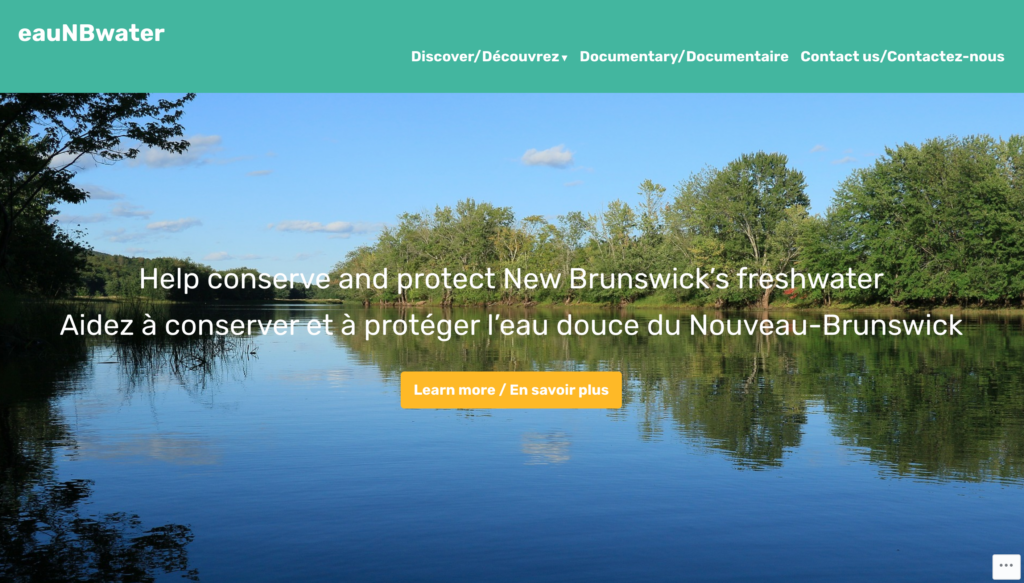“Healthy Waters, Healthy Province” – words that guide the New Brunswick Watershed Caucus
The New Brunswick Watershed Caucus (NBWC) is a forum for about 30 watershed organizations to build capacity and partnerships, contribute to provincial policy and public education, and mobilize knowledge across New Brunswick. Its member organizations started convening monthly in 2015 with administrative support from the Biodiversity and Watershed Programs Coordinator (currently Natalie Goguen) of the New Brunswick Environmental Network (NBEN). The caucus is the main group uniting watershed organizations in New Brunswick and does crucial work for provincial watershed health. (See OLW’s impact story on Quebec’s model for links to the diversity of other regional watershed organizations across Canada.)

Biodiversity and Watershed Programs Coordinator, New Brunswick Environmental Network

Strength: Acting Like A Watershed
Watersheds connect water, land, and living beings together through time and space, and the NBWC is strong because it emulates a watershed.
Across time: The caucus’s structure is set up so that one organization steps up to co-chair one year, and then typically becomes chair the following year, allowing for continuity in knowledge, momentum and leadership.
Between organizations and people: All organizations who attend have the opportunity to contribute to the monthly forum. Members benefit through knowledge sharing (e.g. a pooled provincial projects database) and each other’s support. The caucus brings together francophone, anglophone, and, increasingly, First Nations leadership, and there is strength in the deep relationships between its members. The chairs and co-chairs – currently Colin Forsythe and Sarah Blenis, formerly Briana Cowie and Kelsey Wilson – know they can trust each other and feel genuinely motivated to work together.

Challenge: Shooting the Rapids
While its relationships are strong, the NBWC sometimes faces challenges that feel a bit like shooting the rapids! This year is proving turbulent because a core provincial funding model that many NBWC members rely on lost its source of revenue. The Environmental Trust Fund (ETF) stopped receiving fees from the provincial beverage containers program in April and it is unknown if it will secure new funds in future, potentially running dry in about three years (2027). (See a recent NBEN report for potential impacts on nonprofits and a Radio-Canada report for a French language summary.) What’s more, a 2022 auditor general’s report highlighted shortcomings in ETF governance around roles, responsibilities, planning, evaluation, decision-making, and reporting – so there is also significant uncertainty regarding ETF management moving forward.
The NBWC is now navigating how these changes impact its members. While all caucus organizations provide crucial services for watershed health, different groups rely on the ETF to varying degrees and hold diverging views of what funding advocacy should look like.
Hope: Restoring the Flow
…But the NBWC’s strength comes from its diversity, and its members are embracing this opportunity for renewal – a fresh start to clear that ice jam and restore the flow! Here are some hopes for the coming year from current and former chairs and co-chairs:
- Briana hopes for dedicated time so that leaders can listen equitably to all voices, further strengthening internal relationships and solidifying the collective vision.
- Colin hopes to hold meaningful dialogue with the province, patiently building trust and bolstering provincial recognition of the caucus. He sees the need to think long-term and keep cross-sector lines of communication open.
- Kelsey hopes that with the recent change in government, there can be room to imagine a new funding model for watershed organizations and potentially even replace the ETF.
- Sarah hopes there can be work towards formalizing the caucus, perhaps as a nonprofit like the PEI Watershed Alliance, which provides a strong bridge between the province of Prince Edward Island and its watershed organizations. This could make it easier for the NBWC to act with a unified voice and put less pressure on individual groups.
These are exciting ideas for change. All agree that the caucus finds itself at a watershed moment, with the opportunity for collective renewal in the name of “Healthy Waters, Healthy Province.” If you want to learn more or connect with NBWC water leaders, reach out to nben@nben.ca.